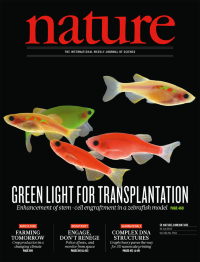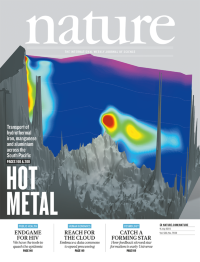Volume 523
-
No. 7562 30 July 2015
Electrically conductive mitochondria in a skeletal muscle cell. How is energy distributed within the cell? In the skeletal muscle, energy distribution has been proposed to occur through metabolite-facilitated diffusion, although genetic evidence has raised questions about the importance of this mode of distribution. Using various forms of high-resolution microscopy, Robert Balaban and colleagues explore whether the mitochondria themselves � as well as actually generating the energy � also have a role in its distribution. They find that they do, by forming a conductive pathway throughout the cell in the form of a proton-motive force. Throughout this network, the mitochondrial protein localization seems to be varied, allowing optimized generation and utilization of the mitochondrial membrane potential. This energy distribution network, which depends on conduction rather than diffusion, is potentially extremely rapid, thereby enabling muscle to respond almost instantaneously to new energy demands. Cover: Ethan Tyler, NIH Medical Arts.
-
No. 7561 23 July 2015
Adult zebrafish engineered to act as a novel competitive marrow transplantation system. Haematopoietic stem and progenitor cell (HSPC) transplantation � with infusions of either bone marrow or peripheral blood progenitor cells � is used clinically to treat certain cancers and diseases of the blood and immune system, but we still understand very little about how HSPCs engraft to the host. Leonard Zon and colleagues have developed a competitive marrow transplantation system in adult zebrafish in which engraftment is measured by in vivo fluorescence imaging of the kidney � the adult haematopoietic site. Using this model to screen for engraftment enhancing activity, the authors identify epoxyeicosatrienoic acids, including 11,12-epoxyeicosatrienoic acid (EET) and 14,15-EET, as agents able to enhance engraftment and HSPC specification through the activation of a transcription factor Runx1-mediated expression program. This activity of EET is conserved in mice, indicating possible clinical potential for EET to promote bone marrow transplants. Cover image: Vera Binder & Ellen van Rooijen
-
No. 7560 16 July 2015
In a collaboration with Scientific American, Nature takes a look at modern movements in teaching science, technology, engineering and mathematics (STEM). By applying the principles of twenty-first century learning, educators should be able to produce scientists better prepared for the modern, multidisciplinary workforce and a more science-literate populace in general. Cover: Vasava
-
No. 7559 9 July 2015
A three-dimensional view of dissolved iron across the South Pacific Ocean. Deep-sea hydrothermal vents are an important source of iron, an essential trace element that can limit marine productivity. Recent studies have questioned the long-standing view that most of the iron discharged from such vents is removed from seawater close to its source, and is therefore of limited importance for ocean biogeochemistry. Joseph Resing et al. report on the lateral transport of hydrothermal dissolved iron and other trace metals from the southern East Pacific Rise more than 4,000 km across the South Pacific Ocean. Using data from samples collected from 35 hydrographic stations between Manta, Ecuador and Papeete, Tahiti, the authors estimate an input of global hydrothermal dissolved iron to the ocean at least four times greater than previously reported. With the help of a model study, they suggest that physicochemical stabilization of iron enables hydrothermal activity to significantly affect the carbon cycle by supporting phytoplankton growth in the Southern Ocean. Cover: 3D graphics created by Reiner Schlitzer, Alfred Wegener Institute, Helmholtz Centre for Polar and Marine Research, Bremerhaven, Germany.
-
No. 7558 2 July 2015
An Australian bearded dragon (Pogona vitticeps) seen basking near the township of Eulo in the semi-arid zone of western Queensland. There have been repeated evolutionary transitions in reptiles between genetic and temperature-dependent sex determination, the regulatory process that initiates differentiation of the gonads in the early embryo to form either testes or ovaries. Various mechanisms have been proposed to explain the transition, including a role for sex reversal. Clare Holleley et al. present the first report of reptile sex reversal in the wild, associated with rapid transition between genetic and environmental sex determination. They observe sex reversal in Pogona vitticeps at the warmer end of its geographic range. When sex-reversed females mate with normal males, the chromosomal sex determination system is lost and temperature-dependent sex determination is established. It is not known whether climate-induced changes in sex determination are advantageous or detrimental to the process of evolutionary adaptation. (Cover photo: Arthur Georges)





